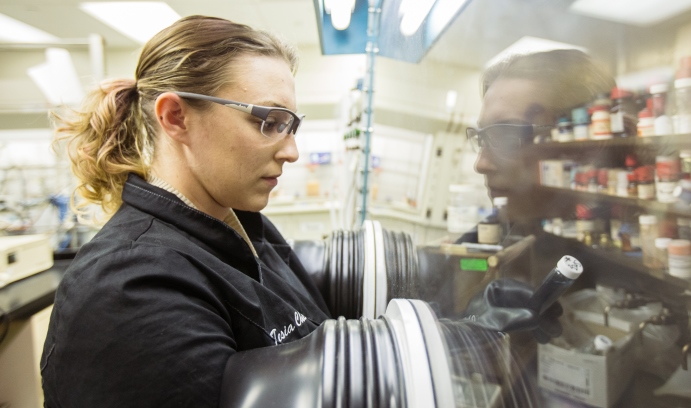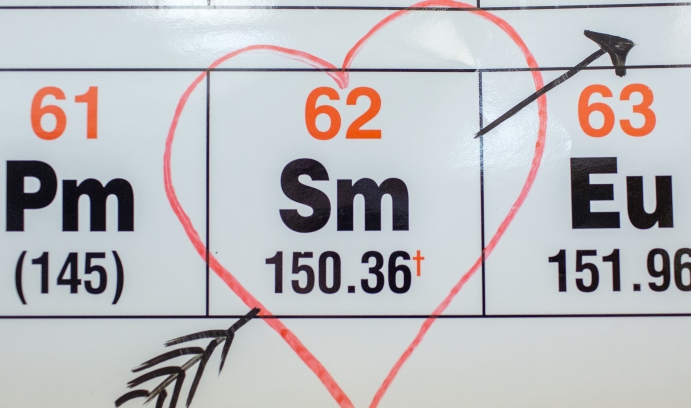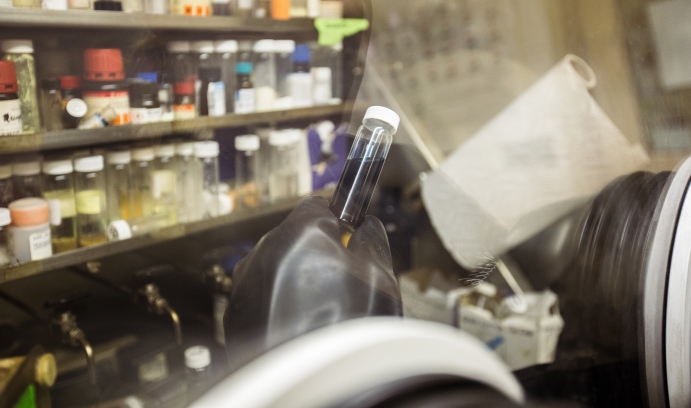A Versatile Chemist Rises to the Top

Tesia Chciuk works with samarium, a highly sensitive Rare Earth element, inside an air-free glove box. Last month, Chciuk successfully defended her Ph.D. thesis in chemistry and became the first Lehigh student to win the Anna Louise Hoffman Award for Outstanding Achievement in Graduate Research.
Tesia Chciuk took an early interest in science.
When she was four years old, she says, her mother found her in the yard attempting to measure the speed at which a blade of grass grows.
In high school, she explored faster phenomena.
“My dad taught me how to make fireworks,” she says. “I won the student of the month award for doing an explosives demonstration in my chemistry class.”
At Cedar Crest College, Chciuk majored in chemistry. After graduating, she spent three years in industry developing green, sustainable technologies.
Last month, Chciuk completed a Ph.D. in chemistry at Lehigh. She also became the first Lehigh student to receive the Anna Louise Hoffman Award for Outstanding Achievement in Graduate Research from Iota Sigma Pi, the National Honor Society for Women in Chemistry. The award is given annually to one graduate student in the United States.
Chciuk attributes much of her success to the wide array of experiences she has had as a scientist.
“I’ve been fortunate to be able to study several different areas of chemistry,” she says. “At Cedar Crest, I did organic synthesis. In industry, I had the chance to do electric chemistry and then analytic and inorganic chemistry.
“At Lehigh, I switched to something completely different—physical organic chemistry.”
Robert A. Flowers, professor of chemistry and Chciuk’s adviser at Lehigh, credits her innate ability, work ethic and maturity.
“Tesia has good natural intuition, and she’s incredibly hard-working,” he says. “She also works very well without supervision. Most graduate students acquire this ability by the end of their training. Tesia worked independently almost from the beginning.
“What I like most about Tesia, though, is that I would sometimes suggest an experiment for her to do, only to find out that she had already thought of it herself and carried it out.”
Explaining samarium’s reactivity
Tesia Chciuk (pronounced “Chuck”) had made a name for herself long before receiving the Anna Louise Hoffman Award.
From 2009 to 2012, she helped Eos Energy Storage improve the performance and storage capacity of its zinc-air batteries, which use no toxic materials and can back up power grids. She was awarded a U.S. patent, and has several patent applications pending.
From January until September of 2012, Chciuk was scientific research director for Bethlehem Apparatus Co. Inc. She set up a new laboratory and supervised the recovery and safe disposal of highly toxic liquid mercury, much of it from mining waste. She also oversaw quality control, quality assurance and process development.
When she left Bethlehem Apparatus to enroll in Lehigh’s graduate program, the company offered to hold open her position and her title until she completed her Ph.D.
In her five years at Lehigh, Chciuk conducted research into samarium (Sm), a Rare Earth element and number 62 on the Periodic Table. She and Flowers were the first to explain how samarium achieves an unexpectedly high degree of reactivity when combined with water. Chciuk published six papers in high-impact journals such as the Journal of the American Chemical Society and Angewandte-Chemie, and has several papers in review. She also mentored five undergraduate students.
“Samarium is an organic reagent, a reductant,” says Chciuk. “Reactions using samarium are typically carried out with different additives that enable us to tune the reactivity to perform different organic reactions.”
Scientists had already discovered the high degree of reactivity of Sm-water, says Chciuk. She and Flowers showed that the reactivity is achieved when the Sm-water combination undergoes a proton-coupled electron transfer, bypassing high-energy intermediates that occur during a simple electron transfer.
By bypassing these intermediates, says Chciuk, Sm-water “is able to react with things that are more recalcitrant, more difficult. In my first paper in the Journal of the American Chemical Society, I explained how Sm-water was able to reduce anthracene. Based on the redox potential alone, it should not have been able to do that reaction, but it does it very quickly.
“Anthracene is a polycyclic hydrocarbon. From what we knew before, the reaction shouldn’t work. We weren’t the first to show that the reaction works, but we were the first to explain why it works.”
Chciuk and Flowers reported their results in the Journal of the American Chemistry Society in an article titled “Proton-Coupled Electron Transfer in the Reduction of Arenes by SmI2−Water Complexes.”
Chciuk’s research is fundamental, not applied, but its consequences will be felt soon.
“Samarium is expensive,” she says. “The metal costs about $15 a gram. Because samarium is not a catalyst, it’s not regenerated; you consume it all when you do a reaction. If you’re using grams of samarium at a time, the cost adds up, especially if you want to do large, industrial-scale reactions.
“Now that we have a fundamental understanding of how this chemistry operates, the goal is to design a catalytic conversion so that we can use much smaller amounts of samarium, or even develop a more efficient version of its reactivity. That’s the value of fundamental research: In order to make something work better, you have to know first how it works.”
Besides being expensive, says Chciuk, samarium is sensitive to air and moisture; thus, her experiments must be carried out in an air-free environment.
Chciuk uses a stop-flow spectrometer (SFS) to measure the rate of a samarium-water reaction and the role played by each of its reactants.
“I measure the rate of a reaction using SFS. Once we know the rate, we’re able to isolate the roles of the different components in a reaction. By looking at two different solvents, we were able to show that changing a solvent can cause the rate of reduction to occur much, much slower.
“You want a reaction to go quickly. This gives us an idea of the importance of a solvent.”
The SFS, says Chciuk, has two pistons that keep reactants separate, enabling researchers to vary each component in a reaction and thus determine how it affects the rate of the reaction. The reaction is monitored by the SFS from beginning to end.
“The SFS monitors the change in color,” says Chciuk. “The samarium starts out a very deep blue and turns a very light, almost colorless yellow as the reaction takes place. The speed at which this reaction occurs, at which the color change occurs, depends on the concentration of the reactants and on the substrate on which the reaction is being performed.
“Our work looks at how you can optimize a reaction, at understanding what’s going on so that you can optimize it. If you understand how a reaction happens, you can optimize all of your conditions for that reaction.”
A timely upgrade for a key instrument
At Lehigh, Chciuk learned the value of collaboration and of asking questions.
“You have to talk to people to get new ideas or to work through problems,” she says. “Working for Bob, I’ve learned to ask more questions. There are no dumb questions as long as you’re asking questions, looking things up and teaching yourself. Lehigh is a lot about teaching yourself.
“In grad school, you learn to be a scholar. You learn what questions to ask. The whole point of grad school is not so much to become an expert but to learn how to learn.”
Chciuk also learned the value of being assertive. She points to the stop-flow spectrometer, one of only two at Lehigh, which Flowers acquired several years ago.
“I made Bob upgrade this instrument,” she says. “When I started here, we had a system that used floppy disks. You had to take the floppy disk to another computer to get the data onto a USB drive. Only then could you work with your data. It was a multi-step process just to get a graph off a screen; it took an hour to move data.”
“I told Bob, ‘There are fewer and fewer things with floppy disks nowadays. We have to fix this.’”
The old instrument could only measure reactions that took 10 minutes or less, says Chciuk, and it had little storage space.
“Now that the system is upgraded, we could do 12-hour reactions if we wanted to. And there’s no limit to how much data the new system can hold.”
After several months of lobbying, Chciuk says, Flowers purchased the new instrument.
“I told him I would do so much more work for him if he would upgrade the instrument,” she says.
“I think I kept up my end of the deal.”
Story by Kurt Pfitzer
Photos by Christa Neu
Posted on:






